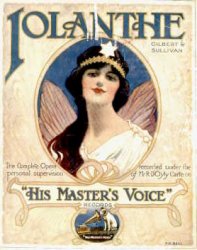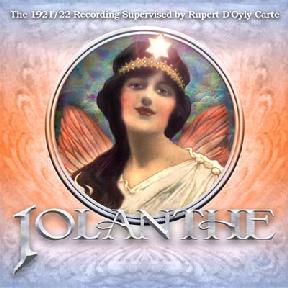The 1922 HMV Iolanthe
Chorus: The Soloists, plus Edward Halland, Conductors: Harry Norris and George W. Byng
Recorded in London, |
|
 HMV Album Cover |
This recording was the sixth in a series that, although nominally produced "under the direction of Mr. Rupert D'Oyly Carte," had employed very few D'Oyly Carte singers up to this point—the only important exceptions being Derek Oldham's Fairfax on the 1920 Yeomen and Frederic on the 1920 Pirates.
With this recording of Iolanthe, the barriers against using authentic singers began gradually to fall. Three D'Oyly Carte singers—Oldham, Sydney Granville, and Darrell Fancourt—were cast in principal roles. All three would later record the opera in 1929 (Granville as Private Willis, not Strephon).
Some confusion has surrounded Darrell Fancourt's contribution to this recording. Wolfson does not note his participation. Francis says that he sings Mountararat only on sides 8 & 18. In fact, Fancourt sings the role on at least sides 8, 9, 10 & 18 (i.e., all those recorded on 6 April 1922 that have a part for Mountararat). He is also listed on the record labels. Harry Arnold sings the part on sides 15 & 20, and Peter Dawson sings it on the remaining sides. The division of Tolloller is more straightforward: Derek Oldham sings all but "In vain to us you plead" (s. 15) and the Act II finale (s. 20).
Even more confusing is the allotment of the conducting chores. Depending on what set you examine, the labels either credit George W. Byng for all twenty sides, or a mixture of Byng and the D'Oyly Carte's Harry Norris. Francis says that Byng conducted sides 1–2, 4–7, 13–14, & 16, with Norris conducting the rest, and this appears to be correct.
The story of the recording appears to be that Byng led recording sessions for 14 of the 20 sides on 7 & 13 December 1921, 13 January 1922, and one other date in early January. Three months went by before the performers reassembled, on 6–7 April. For these sessions, Norris replaced Byng. Norris conducted the remaining six sides, and he also redid five of the sides that Byng had led in the earlier sessions. Fancourt joined for the first time on 6 April. His absence on 7 April is peculiar.
The set, as first issued, mistakenly credited Byng with all twenty sides. After HMV realized the mistake—perhaps Norris himself pointed it out—the set was reissued with correct record labels. However, it was common for people to buy single records and to assemble sets over time. Records that credited Byng were not withdrawn, so one may find sets with Norris credited with anywhere between zero and eleven of the sides. All copies have the same catalog and matrix numbers, regardless of who is listed as conductor.
Further complicating the matter, Adrian Bridgeman and Peter Parker have identified discs from this set published into the 1930s that credit Byng on sides that Norris conducted. It seems that, as discs were re-issued, HMV got careless and once-again misattributed these sides. The only disc known to have been published with two different takes is side 1, the overture. The two takes are quite different, with the timing of the performances disagreeing by five seconds.
Peter Parker has observed that Norris was evidently far more strict than Byng about what sides he would accept. None of the Norris sides are take 1. Out of his 11 sides, 5 are take 4, 2 are take 3, and 4 are take 2. Of the Byng sides, 4 are take 2, and 6 are take 1 (allowing for the issue of two takes of side 1). Byng was an HMV house conductor, and he likely would have had far less affinity for the material than the D'Oyly Carte's Norris.
The 1929 recording is of greater interest, since it features D'Oyly Carte singers in nearly all of the roles. However, for those with a taste for vintage recordings, Chris Webster and J. C. Lockwood 78s 2 CD have each issued the recording on CD at an extremely reasonable price. This is what Chris had to say about his release:
Derek Oldham had already appeared in several recordings, but this recording was the first to feature D'Oyly Carte singers on a more major scale with the first appearance on record of Sydney Granville singing his then juvenile stage role of Strephon (he was still quite a few years away from taking over the 'Pooh-Bah roles') and the great Darrell Fancourt also makes his debut on record, sharing the role of Mountararat with Peter Dawson. Together with Derek Oldham these "D'Oyly Doyens" are ably supported by HMV's own selection of artists including George Baker, Peter Dawson, Robert Radford, Harold Wilde, Harry Arnold, Violet Essex, Nellie Walker, Bessie Jones, Evelyn Harding and Edna Thornton.
This recording has previously been available direct from its transferor Jim Lockwood, but this is his most recent transfer (transfer code ‘D’) which has only been available to more recent customers and offers considerable audio improvements over the earlier versions. Of course, I have completely re-edited Jim's basic present transfer especially for this release to match the Sounds on CD criteria of musical continuity wherever necessary, plus frequent convenient track cue points (41 in this instance).
Review from The Gramophone, 1927
| Date | Label | Format | Number |
|---|---|---|---|
| 1923 | HMV | 78rpm | D 632-641 |
| 1998 | 78s 2 CD | CD | GS02 |
| 2000 | Sounds on CD | CD | VGS219 |
| Side Nbr | Matrix Number | Face Nbr |
Selection | Rec. Date |
|---|---|---|---|---|
| 1 | Cc766-1 Cc766-2 | 3-0742 |
|
9 Dec 21 |
| 2 | Cc772-2 | 04730 |
|
13 Dec 21 |
| 3 | Cc773-4 | 04731 |
|
7 Apr 22 |
| 4 | Cc771-1 | 02947 |
|
13 Dec 21 |
| 5 | Cc776-1 | 04732 |
|
13 Dec 21 |
| 6 | Cc774-2 | 04733 |
|
13 Dec 21 |
| 7 | Cc775-1 | 02948 |
|
13 Dec 21 |
| 8 | Cc1197-2 | 04734 |
|
6 Apr 22 |
| 9 | Cc901-4 | 04735 |
|
6 Apr 22 |
| 10 | Cc1198-3 | 04736 |
|
6 Apr 22 |
| 11 | Cc1200-3 | 04316 |
|
7 Apr 22 |
| 12 | Cc1199-2 | 03788 |
|
6 Apr 22 |
| 13 | Cc897-1 | 02949 |
|
13 Jan 22 |
| 14 | Cc898-2 | 02950 |
|
13 Jan 22 |
| 15 | Cc899-4 | 04737 |
|
7 Apr 22 |
| 16 | Cc900-1 | 03789 |
|
13 Jan 22 |
| 17 | Cc863-4 | 02951 |
|
7 Apr 22 |
| 18 | Cc1196-2 | 04317 |
|
6 Apr 22 |
| 19 | Cc864-4 | 04738 |
|
7 Apr 22 |
| 20 | Cc1201-2 | 04739 |
|
7 Apr 22 |
Notes:
- For side 1, Francis cites only Cc766-2, but Chris Webster has confirmed the existence of both of the matrices listed above.
- Side 11 was included on Arabesque's LP reissue of the 1931 Ruddigore.
- Substantial excerpts from this recording were included on Pearl GEM 125, a Derek Oldham retrospective disc.
| Result | Matrix Number |
Selection | Rec. Date |
|---|---|---|---|
| Session One, 9 Dec 1921 — Conducted by George W. Byng | |||
| Issued s. 1 | Cc766-1 Cc766-2 |
|
9 Dec 21 |
| Session Two, 13 Dec 1921 — Conducted by George W. Byng | |||
| Issued s. 4 | Cc771-1 |
|
13 Dec 21 |
| Issued s. 2 | Cc772-2 |
|
13 Dec 21 |
| Rejected | Cc773-1 Cc773-2 |
|
13 Dec 21 |
| Issued s. 6 | Cc774-1 Cc774-2 |
|
13 Dec 21 |
| Issued s. 7 | Cc775-1 |
|
13 Dec 21 |
| Issued s. 5 | Cc776-1 |
|
13 Dec 21 |
| Session Three, Date Uncertain — Conducted by George W. Byng | |||
| Rejected | Cc863-1 Cc863-2 |
|
???????? |
| Rejected | Cc864-1 Cc864-2 |
|
???????? |
| Session Four, 13 Jan 1922 — Conducted by George W. Byng | |||
| Issued s. 13 | Cc897-1 |
|
13 Jan 22 |
| Issued s. 14 | Cc898-1 Cc898-2 |
|
13 Jan 22 |
| Rejected | Cc899-1 Cc899-2 Cc899-3 |
|
13 Jan 22 |
| Issued s. 16 | Cc900-1 |
|
13 Jan 22 |
| Rejected | Cc901-1 Cc901-2 Cc901-3 |
|
13 Jan 22 |
| Session Five, 6 April 1922 — Conducted by Harry Norris | |||
| Issued s. 18 | Cc1196-1 Cc1196-2 |
|
6 Apr 22 |
| Issued s. 8 | Cc1197-1 Cc1197-2 |
|
6 Apr 22 |
| Issued s. 9 | Cc901-4 Cc901-5 |
|
6 Apr 22 |
| Issued s. 10 | Cc1198-1 Cc1198-2 Cc1198-3 |
|
6 Apr 22 |
| Issued s. 12 | Cc1199-1 Cc1199-2 |
|
6 Apr 22 |
| Session Six, 7 April 1922 — Conducted by Harry Norris | |||
| Issued s. 15 | Cc899-4 Cc899-5 |
|
7 Apr 22 |
| Issued s. 11 | Cc1200-1 Cc1200-2 Cc1200-3 |
|
7 Apr 22 |
| Issued s. 20 | Cc1201-1 Cc1201-2 Cc1201-3 |
|
7 Apr 22 |
| Issued s. 3 | Cc773-3 Cc773-4 |
|
7 Apr 22 |
| Issued s. 19 | Cc864-3 Cc864-4 |
|
7 Apr 22 |
| Issued s. 17 | Cc863-3 Cc863-4 |
|
7 Apr 22 |
Notes:
- The table above lists the order in which the sides were recorded. Where there were multiple attempts at a side on the same day, none of which are known to have been issued, the entire row is shown in italics, and the word "Rejected" appears in the "Result" column.
- Where there were multiple attempts at a side on the same day, at least one of which was issued, the word "Issued" and the side number appear in the "Result" column. For takes not known to have been issued, the matrix number is shown in italics.
- Details of unissued takes were supplied to Chris Webster by David Mason, whose information comes from the National Sound Archive.

